Sporting Life

Black Squirrels in the Winter Landscape
By Dennis Doyle
The snowflakes cascading into my yard are a lovely sight, especially since my fireplace is blazing and everyone inside is toasty, including me. I’ve got books piled next to my spot on the couch and my pup, Hobbes, has already positioned himself as my footwarmer. There aren’t many places I’d rather be right now.
Out on the newly white landscape this morning I immediately noticed our latest resident. I have finally persuaded my black squirrel buddy into our front yard tree line. Luring it with copious amounts of sunflower seeds beginning last summer, he (squirrel genders are obvious) has finally moved from the backyard area into a more visible location out front.
Being easy to spot, he makes an interesting visual counterpoint to the rowdy bunch of grays that chase each other up and down the trees in front, occasionally falling out, bouncing on the ground and bounding back up into the upper reaches. The eastern gray squirrel, of which the black squirrel is simply a recessive color variant, mates twice a year, each spring and each fall. I’ve noticed, however, that they all often mistake any warm spell that occurs during the long winter months for springtime.
I’m also reminded of a story that explains the presence of this black, or melanistic, color phase of the eastern gray squirrel. Before the European migration to America, the story goes, the entire East Coast was solidly forested with mature trees and little light penetrated below the thick, leafy canopy. Since black fur is less visible to the marauding hawks, owls, eagles, fishers and pine martens that preyed on the lush population of squirrels for their sustenance, the black phase became more numerous than the grays, until agricultural practices of the colonists thinned out the forests and the grays regained dominance.
Another theory is that black fur gave the squirrels carrying the color variant an advantage of better heat retention during colder months and also explained why the populations of this color of tree acrobats are greater in the Canadian provinces, especially Ontario.
Still a third legend posits that a number of black squirrels were released by Teddy Roosevelt in the District of Columbia, a gift from admirers in Canada. They subsequently spread out but remain quite populous in the District to this day, maintaining a solid presence in many of the parks of our nation’s capital.
Whatever the origin of this particularly handsome critter, they do appear throughout the U.S. There are notable populations in Ohio, Michigan, Pennsylvania, Kansas and gradually increasing in a number of other states. We’ve also exported them to the U.K. (much to their surprise).
As I’ve traveled through my community though, there’s always a black squirrel or two among the grays about every other block and I’m told that the Eastern Shore has a few areas where large numbers of black squirrels remain. They are generally regarded as good luck and an interesting addition to the local fauna. And if you’re interested in seeing them up close, they’re quite fond of sunflower seeds.
Fishfinder: Temporarily suspended due to ridiculously uncooperative weather.
